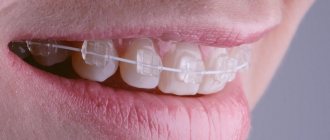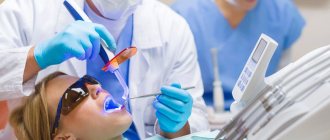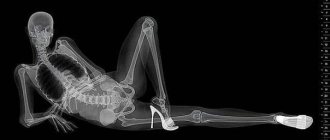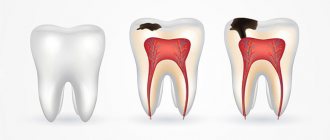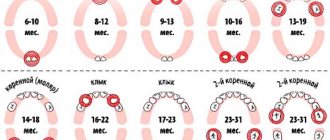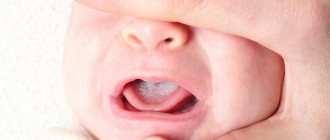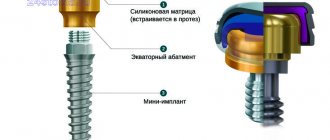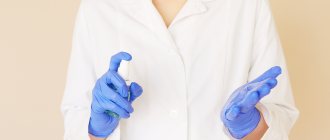Caries is the most common oral disease. Therefore, there is a constant search for new, more durable materials and treatment methods. In order for the filling to serve for a long time and the tooth underneath it not to be destroyed, there are certain algorithms for performing treatment. One of them is the use of an alcohol adhesive protocol.
In the last 5-7 years, this method has become very popular among dentists. The first studies on this topic appeared back in 2007.
General information
What is adhesion
Adhesion is the bond of bond (dental glue) with tooth tissue (enamel and dentin).
And the filling material is already attached to the glue. Without it, it is impossible to glue the light seal. Bond is divided into 7 generations, each with its own characteristics of application and strength of adhesion to the tooth. The 4th generation is usually used in the alcohol protocol. The better the enamel and dentin are prepared, the more durable the bond and restoration will be.
Essence of the protocol
Dentin contains an enzyme that is activated when the tooth is processed. It is this that over time destroys the adhesive layer (the connection between tooth tissue and material). It can also be found in saliva and gingival fluid. The use of an alcohol adhesion protocol is aimed at neutralizing this enzyme.
If the cavity is poorly dried, the service life of the filling will be reduced. If you overdry it, too, since the glue will not penetrate well into the tooth tissue. In addition, in both cases, the patient will be bothered by severe sensitivity from cold and hot, or when biting on a tooth.
It is necessary to know the methods of the alcohol adhesive protocol and the nuances of its implementation. The survival of the restoration and the health of the tooth depend on this. Methods are divided into complete and incomplete.
The use of chlorhexidine in the adhesive protocol: literature analysis and expert opinions
The influence of chlorhexidine on the quality of the formation of an adhesive connection between the composite restoration and the treated walls of the dental cavity has been a topic of discussion and discussion among scientists and practicing dentists for many years.
This article analyzed a number of scientific articles, and also obtained the opinions of practicing dentists on the use of chlorhexidine.
The advisability of using chlorhexidine at the stage of adhesive treatment of the prepared cavity is justified by the possibility of inactivating matrix metalproteinase (MMP) enzymes, which have collagenolytic, gelatinolitic effects and enamel-lysis activity. Given the corresponding activity of matrix metalproteinases, the connection between their action and the progressive degradation of the interface between the tooth structure and the composite material becomes quite logical.
Photo 1. The mechanism of formation of an adhesive connection, which is degraded over time under the action of metalproteinases.
Photo 2. Schematic illustration of the degradation of the bonding layer.
This process is critical in the area of the intermediate bond layer and adhesive-infiltrated dentin, since it is this area that provides the chemical retention of the filling. The action of metalproteinases is manifested precisely by insufficient infiltration of the enamel and dentin structures with the proper layer of bond: under such conditions, part of the fibrin fibers of dentin remains exposed, thus providing the opportunity for MMP to penetrate into the gap between the composite and the tooth, where enzymes begin to gradually “pull apart” the adhesive layer. In addition to the dentinal tubules, MMPs can be found in fairly large quantities in saliva and gingival fluid, where they take part in the fermentation process, as well as tissue remodeling, proliferation, migration and differentiation of cells, and apoptosis.
However, the very use of chlorhexidine already raises a number of specific questions: how to use it? according to what protocol? is it needed at all? And is this approach demonstrably effective?
It is known that the use of chlorhexidine at the stages of adhesive processing is possible using several protocols:
- First, treatment of the cavity with chlorhexidine, then washing, etching and subsequent application of adhesive;
- Using chlorhexidine before etching without additional cavity rinsing;
- The use of chlorhexidine after etching followed by rinsing the cavity;
- Using chlorhexidine as a solution for rinsing the cavity after the etching procedure.
"Staging" and temporary exposure to the use of chlorhexidine
Japanese researchers Chang and Shin argue that the best effect from the use of chlorhexidine can be achieved by using it strictly after etching the cavity as an additional treatment before applying the adhesive. Already other Japanese under the leadership of Hyun-Jung Kang have proven that the exposure time of chlorhexidine, in fact, does not play an important role in ensuring the appropriate effect of using the solution. Testing by researchers of temporary exposures of 5, 15, 20 and 60 seconds after etching and subsequent washing of the dentin surface did not reveal any difference in the effect obtained, thus, 5 seconds of chlorhexidine is sufficient to provide the desired effect of the adhesive bond.
Expert opinions regarding the use of chlorhexidine also differ.
So, Olga Tkachuk , for example, does not use the solution in her work: “I do not use chlorhexidine treatment of the carious cavity in my work at any stage of treatment. It is impossible to achieve complete sterility in a carious cavity, and I consider the effect of chlorhexidine in increasing the durability of the adhesive layer to be insufficiently proven.”
Others argue that the use of chlorhexidine is inappropriate due to the lack of appropriate recommendations in the instructions of manufacturers of adhesive systems.
For example, Alexey Sazonov opposes the use of chlorhexidine in general, since, in his opinion, “MMPs are needed for the transition of altered dentin to sclerotic types.”
Some practicing dentists, in particular Roman Vasiliadis , express their opinion more than categorically in their answers to such questions: “I can answer right away, I don’t use it, I conducted experiments, but refused to use this solution...”.
It should be noted that the use of chlorhexidine has also found its supporters, among whom is Alexander Grigoriev : “I use a solution of chlorhexidine both as an antiseptic and as an MMP inhibitor in the total etching technique.”
Or, for example, Roman Aliyev Fr.
Denis Krutikov took neutrality on this issue , saying: “I don’t use HG. But I’m neither for nor against, because it is needed in some cases.”
Chlorhexidine concentration: what should it be?
Be that as it may, but if there are not so many questions with the stage and time exposure of the use of chlorhexidine, then with the required concentration everything is much more complicated. Preliminary laboratory studies have demonstrated that chlorhexidine concentrations of 0.001% are sufficient to inactivate MMP-2, 0.02% for MMP-8, and 0.002% for MMP-9. However, how effective such low concentrations of the drug are for the entire complex of metalproteinases has not yet been determined. In addition, at such concentrations of chlorhexidine, it is impossible to achieve its retention interaction with dentin hydroxyapatite, while the use of higher concentrations of the solution (up to 2%) allows for prolonged persistence of the components of chlorhexidine in the tooth structure.
Photo 3. Commercially available forms of chlorhexidine in different concentrations.
American researchers also agreed that the use of higher concentrations of chlorhexidine in the range of 0.1-1.0% provides more successful restoration results in terms of guaranteeing its long-term functioning. With a similar approach to cavity preparation, but using a 0.05% concentration of chloroxydine, no changes in bond strength or longevity of the filling were observed. At the same time, American scientists have clearly determined that such a protocol is effective (or ineffective depending on the concentration) only in cases of using Clearfil SE Bond, thus, having already drawn attention not only to the inactivation effect of chlorhexidine relative to metalproteinases, but also to the specificity its interactions with various bonding systems.
In parallel, ongoing research by Peter C. Moon also argued the advisability of using only 2% chlorhexidine at the stage of etching and washing off the etchant agent, which, according to the author, is currently the only method that provides demonstrably more reliable results for the functioning of composite restorations. This opinion is no different from the argumentation of Chang and Shin, already mentioned above regarding the stages of using the solution.
But let’s return to the issue mentioned by the Americans: as it turned out, the effectiveness of using chlorhexidine also depends on the adhesive system with which it is used.
On this occasion Denis Krutikov , answering the question “Does the possibility of using chlorhexidine depend on the generation of the bond used?”, Fr.
Edson Alves de Campos et al found that the use of chlorhexidine concentrations above 0.12% with self-etching adhesive systems is generally undesirable because such solution concentrations tend to reduce the adhesive bond strength in the immediate follow-up period. On the other hand, the same researchers found that the use of 2% chlorhexidine with “etch-and-rinse” adhesive systems does not cause an immediate decrease in the strength of the adhesive bond, but rather provides longer retention of an adequate bonding interface. When testing Clearfil SE Bond (SE) and Clearfil Protect Bond (PB), Fereshteh S. and colleagues found that chlorhexidine, although it has a positive effect on maintaining proper adhesive bond in the long term, but provokes its decrease immediately after polymerization, thus increasing the risk of developing possible complications specifically with these two adhesives.
Ricardo de Sousa Vieira noticed another interesting fact: treating the cavity surface with a commercially available 2% chlorhexidine solution before etching the dentin also negatively affects the formation of the adhesive bond when using the Single Bond bonding system. The attentive reader will note that Single Bond precisely belongs to the group of self-etching adhesives that Edson Alves de Campos warned about. A study by Deng D et al found that chlorhexidine provided better bond retention when using Single-Bond (but in an etch-and-rinse protocol), while it had no effect when using self-etching G-Bond, which was applied according to the manufacturer's protocol. But the Brazilians not only confirmed this fact, but went even further and proved that the use of an etching gel containing 2% chlorhexidine also does not provide a better effect compared to the classic protocol for etching tooth dentin without the use of any disinfectants.
Stanislawczuk R. and colleagues can argue with the latter judgment, who, in order to avoid direct interaction between chlorhexidine and the bond components, proposed the use of a special acid agent containing 2% chlorhexidine. When testing this approach with two adhesive systems, Prime & Bond NT (PB) and Adper Single Bond 2 (SB), researchers noted positive effects on both systems over a two-year follow-up. Similar results were obtained by Loguercio AD, who tested, in addition to the corresponding chlorhexidine-containing acid, also the use of a water-soluble chlorhexidine-containing primer. Both preparations provided long-term stability of the composite-dentin joint during observation.
For a similar purpose, Abu Nawareg M (2016) and colleagues conducted a study that compared the effect of using conventional chlorhexidine digluconate and modified chlorhexidine methacrylate. It turned out that both forms of chlorhexidine have a positive effect on the duration of the restoration’s functioning, but, given the specific chemical structure of chlorhexidine methacrylate, it provides a longer effect, since it copolymerizes with the monomers of the composite, thus guaranteeing long-term retention of the active substance. In terms of chlorhexidine content, Peak Universal Bond is universal, which already contains 0.2% chlorhexidine.
Photo 4. Peak Universal Bond is an adhesive that contains 0.2% chlorhexidine.
But a comparative study by Sabatini S. did not reveal a difference in the effectiveness of the use of Peak Universal Bond and the isolated use of chlorhexidine as a compounding agent at the stages of cavity adhesive treatment. Similar concentrations of chlorhexidine (0.2%) are also found in such modified forms of bonds as XP Bond [XP] and Ambar {AM}. Moreover, the presence of exactly this concentration of chlorhexidine in the adhesive composition does not demonstrably affect the physical and mechanical properties of the bonding system.
An alternative to chlorhexidine, according to experts , is the following:
- ready-made solutions for dentists with an appropriate cost (Alexey Soshnikov) ;
- ammonium compounds from a series of antiseptics (Alexey Sazonov) ;
- only preparation and rinsing with distilled water (Olga Tkachuk) ;
- acid with benzalkonium chloride (Alexander Grigoriev) .
Use of chlorhexidine in combination with other agents
Separate European studies have demonstrated the effectiveness of the simultaneous use of chlorhexidine and ethanol during the adhesive preparation stages of the cavity (thereby reducing the level of microleakage, which was re-evaluated 12 months after the procedure). Other studies, on the contrary, have demonstrated the lack of a complex effect of using chlorhexidine and ethanol compared to the isolated use of ethanol alone, although the facts obtained are very, very contradictory with a huge amount of sufficiently confirmed data. In 2012, Lenzi TL and colleagues demonstrated that chlorhexidine does not provide immediate improvement in adhesive bond strength to both healthy and caries-affected hard tissue structures of primary and permanent teeth. In other words, if the issue of ensuring long-term stability of the adhesive layer with the help of chlorhexidine can still be considered more or less resolved, then the aspect of the formation of an immediate adhesive bond and the risks of its disruption remains open to debate. If we consider the specifics of the formation of a bond between the bond and the hard tissues of the tooth under the conditions of treating the latter with chlorhexidine, then the same Brazilians came to the conclusion that in the early period of observation the level of dentin demineralization is the most critical and influential factor regarding the formation of an adequate bonding interface, at least , when using self-etch adhesive systems. Thus, in cases of insufficient dentin mineralization, regardless of the concentration of chlorhexidine used, the latter will not be able to influence the stabilization of the bond between the composite and hard dental tissues.
The question also remains interesting: how to check whether the cavity was treated correctly with chlorhexidine? Alexey Soshnikov adheres to a simple method: “There should be enough of it, there is no need to save it. Moreover, the solution prepared in a pharmacy is inexpensive.”
Olga Tkachuk states the following: “I only allow antiseptic treatment of the cavity with chlorhexidine before all stages of adhesive preparation with rinsing with distilled water and drying. However, it has been proven that in a sealed cavity, bacteria die or become inactive, which defeats the purpose of attempting to sterilize the cavity.”
Alexander Grigoriev answered this question like this: “There are no such signs: simply following the adhesive (drying) technique will be the criterion for a correctly performed procedure. After etching and washing off the acid for 2 times longer than etching, the cavity is filled with CG solution, left for 15-30 seconds, and then the wet drying procedure.”
Thus, before using chlorhexidine, the doctor at the stage of adhesive treatment of the dental cavity needs to familiarize himself with the results of relevant studies already available online in order to determine the possibility of a promising complex use of this solution together with the appropriate adhesive, without violating the manufacturer’s recommendations.
In addition, within the framework of the topic under discussion, the problems of which require ambiguous answers, the exchange of experience and knowledge is of some value. In order to discuss current issues of using chlorhexidine in an adhesive protocol and determine the promising capabilities of this solution, a joint discussion of this topic in the comments will be very valuable and useful.
Share your experience and practical advice in the comments - because only together we can discuss the nuances and weigh the pros and cons regarding the use of chlorhexidine.
Stages
For high-quality restoration, the working field is isolated from saliva with a rubber dam or other system. Protocol:
- Etching of enamel - 10-15 seconds, dentin - 3-5 seconds.
- Washing off the acid with a stream of water or a water-air spray. Must be equal to or greater than the etching time. By no means less. Do not dry.
- Rinsing the cavity with alcohol (from 70%, preferably 95%) or an alcohol solution of Chlorhexidine from a syringe for 60 seconds. You can rinse one at a time - first with Chlorhexidine, then with alcohol. Dry slightly, you can remove excess moisture with paper pins.
- For 5th generation bond and higher: apply adhesive, rub it into the cavity for 10-15 seconds. Dry slightly. Then a second layer is applied (the same as the first) and blown until the “waves” disappear. For 4th generation bond: apply primer at least 2 times, each layer must be rubbed in and inflated! Apply the bond in the same way.
- Applying a thin layer of flowable composite to the bottom of the cavity.
- Polymerization according to the instructions for the adhesive.
During the adhesive preparation process, the cavity must be constantly moistened! Do not overdry fabrics.
Trends in luting methods for indirect restorations
Dr. Sam Simos
In recent years, indirect restorations have become more and more in demand among patients, and this demand has led to the further development of dental prosthetics. There was a demand among patients for highly aesthetic denture materials that do not have metal frames, and dentists gave patients what they asked for. At the same time, the emergence of new restorative materials, adhesive systems and cements has introduced confusion and complexity into the treatment process. The purpose of this article is to provide an overview of available cements and adhesive systems, as well as optimal schemes for their use.
Cementation or adhesion: what to choose?
Very often, specialists, when talking about fixation of indirect restorations, use the terms “cementation” and “adhesion” as synonyms, but in fact the difference between these concepts is significant. Cementation refers to a process in which mechanical retention is achieved using cement. While adhesion can be defined as the joining of two dissimilar materials either mechanically or through chemical bonds. Bonding is the process of joining materials together. This distinction is made for the sole purpose of demonstrating the superiority of the adhesive approach in bonding strength when fixing dissimilar materials (for example, tooth and crown).
Rice. 1. Scheme for choosing cement depending on the height of the stump and its taper
For many years, metal was the only material on the dental market, requiring only one type of luting cement to be stocked in the clinic. The emergence and widespread use of new materials based on zirconium (Lava, 3M) and lithium disilicate (IPS e.max Ivoclar Vivadent), which occurred in 2001 and 2005, respectively, required the development of new materials and technologies for their fixation. Soon after the use of these materials began, it became apparent that the use of traditional methods was often inappropriate. The chemistry of lithium zirconium disilicate is so different from current metal and metal-framed crowns that different adhesive protocols and materials must be used. In particular, the surface of lithium zirconium disilicate is hydrophilic and has high energy, which is bad for adhesion. Therefore, a step was needed to prime the surface of the restoration so that it becomes hydrophobic and has low energy, in which case the cement can bond reliably to it. This is achieved by applying a special primer to the inner surface of the crown before fixation and subsequent drying. Typically, for this purpose, silane is used for lithium disilicate, and for zirconium, a special primer is used (for example, Z-PRIME Plus, Bisco Dental Products), produced by many manufacturers. A universal primer has recently been introduced (Monobond Plus, Ivoclar Vivadent) that can be used for metal, metal-framed crowns and all-ceramic restorations, including leucite ceramics (such as IPS Empress Esthetic, Ivoclar Vivadent) as well as other high-strength ceramics such as disilicate lithium (IPS e.max or Initial LiSi Press, GC America) and high-strength polycrystalline ceramics such as zirconium.
Currently, the adhesive protocol includes the following procedures: the tooth must be prepared, etched, and an adhesive suitable for the clinical case must be applied to the tooth. Whatever cement is used, the restoration must be treated with an appropriate primer, because only in this case will the cement be able to reliably unite the tooth and the crown material. Although the procedures seem simple, the geometry of the tooth core, the availability of different materials for making crowns, and the many options for choosing cement can confuse even advanced specialists.
Other factors relevant to increasing the service life of a restoration
Clinicians must understand that the geometry of the core and the preparation procedure itself are of equal importance to other factors when bonding new restorative materials to the tooth. To achieve long service life, a core geometry that can provide good retention is as important as the luting cement. The height and taper of the stump are important, since they determine how well the cement will withstand lateral loads during the service life of the restoration.
For good long-term results, high-quality isolation of the surgical field, which can be provided by a rubber dam or other isolation means (for example, Isolite, Isolite Systems), is also key, otherwise the physical properties of the adhesive and cements may be compromised.
Rice. 2. The tooth stump is short. The crown was prepared for cementation. The total etching technique was used. The cement used was Calibra Ceram (Dentsply Sirona).
Rice. 3. Total etching with phosphoric acid Uni-Etch W/BAC 32% (BISCO Dental Products)
Rice. 4. Application of Prime & Bond adhesive (Dentsply Sirona)
Rice. 5. Primer BruxZir Zirconia (Glidewell Laboratories) was added to the crown.
Rice. 6. Adding Calibra Ceram cement to the crown
Rice. 7. The crown is installed on the tooth
Rice. 8. Excess cement was removed after pre-light curing.
Choice of cement
Once the tooth and restoration surface are prepared for cementation, the final step is to apply the cement appropriate to the situation.
The main purpose of cement is to fill the microgap between the crown and the tooth. Another important function is the cementation of the restoration. Nowadays, the clinician has a large selection of cements, from those providing only mechanical retention to adhesive ones, which hold the restoration both mechanically and with the help of chemical bonds. This diversity often leads to understandable confusion about what to choose in a particular clinical situation and how best to use the selected cement. In fact, the choice is influenced by the geometry of the tooth stump (retention properties of the tooth stump and ability to resist loads), the clinical situation and the preferences of the clinician. It is important to note here that if the tooth is prepared unsatisfactorily, little will depend on the choice of cement.
Now let's look at what cements are available to us for fixation.
Glass ionomer cement
Glass ionomer cements (GICs) were introduced to the market in the 1970s. This is traditional cement, which has such properties as a thin film of cement, is not afraid of microleakage and has anti-caries activity due to the release of fluoride. Cements of this group are chemically cured and are indicated for fixation of metal crowns, structures with a metal frame, as well as all-ceramic restorations, in situations where the tooth core can provide good retention and resistance to loads. Since GIC has been in use for a long time, it is well studied and is an extremely reliable cement when used correctly.
Glass ionomer cements modified with composite
Composite-modified glass ionomer cements (GICMCs) appeared on the market in the 1990s and are a hybrid of GIC and composite cements (CCs). GICs have the advantages of traditional GICs, but also have increased strength and ease of use due to their reinforcement with a composite matrix. SICMK are insoluble in oral fluid and can be light-cured. Indications for their use are metal orthopedic structures, structures with a metal frame, as well as restorations made of lithium and zirconium disilicate, if control of microleakage during fixation is difficult. However, it is worth noting that these cements are indicated in the case of a tooth stump geometry that promotes retention, since even the latest generation SICMs cannot compare in strength with composite cements.
Composite cements
Composite cements were commercially available in the 1980s but have only recently become popular after significant development. These are adhesive cements and their versatility and bonding strength make these cements the best choice for luting today. However, it should be noted that clinicians must be able to work with this group of cements as applicable to a specific clinical situation, otherwise their effectiveness will be reduced. Composite cements are divided into three subgroups: chemical-curing, light-curing and dual-curing cements. It should be noted that many composite cements are promoted by manufacturers as universal, but this term is nothing more than a marketing gimmick. When purchasing such material, you must carefully study the instructions to understand what the manufacturer actually meant by the word “universal.”
Light-curing composite cements used in combination with the total etch technique
Cements of this group are used in combination with the total etching technique, that is, the tooth must be etched, the acid washed off, and a bonding agent applied before fixing the crown.
These cements come in a variety of colors and are usually sold as a system of two syringes, one containing the base and the other containing the catalyst. The base can be used without a catalyst, in which case it is necessary to expose the restoration to light to harden the cement. When the base and catalyst are mixed together, a dual-cure cement is obtained. Composite cements of this group should be used only when the cement can be exposed to light of sufficient intensity. A typical indication for this cement is the cementation of veneers on anterior teeth made of transparent glass ceramics (eg lithium disilicate).
Dual-cure composite cements used in combination with the total etch technique
Cements of this group are produced in a double syringe. When squeezed out of such a syringe, the base and catalyst are mixed. Cements of this group are also available in various colors and are produced by many manufacturers. An example of a cement in this group in this article is Calibra Ceram cement (Dentsply Sirona) (Fig. 2-8). Composite cements of this group are also used in the total etching technique, which requires etching the tooth, washing off the acid and applying an adhesive.
Dual-cure CCs used in combination with the total-etch technique are excellent for cases where the tooth core will not support the retention of the restoration, as well as in areas of the mouth where the use of light for curing is difficult.
Self-etching composite cements
A recently developed category of cements is self-etching CC (Fig. 9-13). These cements include an etching and bonding system. Therefore, they are also called self-adhesive cements. The distinctive basis of cement is the special primer included in it, which penetrates through the smear layer of the tooth. These dual-cure cements and excess cement are easily removed after pre-curing the crown margin for 5-10 seconds. Self-etching cements are a good choice in situations where tooth cores contribute to the retention of the restoration, as well as in some cases where retention geometry is insufficient and can be used with all-ceramic lithium zirconium disilicate crowns.
Rice. 9. Prepared tooth stump with good retention properties. The crown is ready to be cemented using Calibra Universal dual-curing self-etching cement (Dentsply Sirona).
Rice. 10. Primer Z-PRIME Plus (BISCO Dental Products) applied to a zirconia crown (BruxZir)
Rice. 11. The crown is filled with self-etching composite cement Calibra Universal
Rice. 12. The crown, fixed after adding cement, was preliminarily illuminated from the side of the tongue for 3 seconds
Rice. 13. Pay attention to the ease of removing excess after preliminary highlighting
In general, the clinician may consider the total etch technique in the following situations:
- After preparation, dentin is almost absent
- The tooth can be qualitatively isolated to create a dry field and carry out bonding
- The geometry of the stump creates conditions for holding the restoration
Self-etching systems can be used:
- Little enamel
- Core geometry promotes retention
If there are small islands of enamel on the stump, it is necessary to carry out a short 3-5 second etching with orthophosphoric acid and subsequently use self-etching composite cements. It is also important to remember that under-etching and over-etching can reduce adhesion strength, so there needs to be a balance in the process.
Conclusion
In the last decade, certain advances have been made in materials science for indirect restorations, which has made it possible to produce higher-quality restorations with a longer service life.
With so many different cements available, it is necessary to understand how to prepare a tooth and how preparation design influences the choice of cement.
What should determine our actions is the clinical situation and the ability of the tooth core to retain the restoration.
Gone are the days when the dentist had at his disposal only one universal cement for all occasions. Now experienced doctors have several different cements at hand and have a clear idea in what clinical situations they can be used.
about the author
Dr. Simos is in private practice in Bolingbrook, Illinois, USA. He received his degree from Loyola University Chicago and is the founder and president of Allstar Smiles Training Center in Bolingbrook, where he teaches postgraduate courses to practicing dentists on the topics of cosmetic dentistry, occlusion and restorative dentistry.
The translation was made by Olga Yukhimenko specifically for the StomPort.ru portal.
Opinion of Alexey Olegovich Sazonov
In the video, Sazonov’s technique:
Alexey Olegovich Sazonov graduated from MGMSU - Moscow State Medical and Dental University named after. A.I. Evdokimov, majoring in Dentistry. Doctor - dentist-therapist, orthopedist, chief physician of the Art-pro clinic. Work experience - 19 years.
He does not use Chlorhexidine, because he considers its action useless: “MMPs are needed for the transition of altered dentin to sclerotic types.” This is necessary in the presence of deep caries, to strengthen the affected but healthy tissues. Chlorhexidine, according to the doctor, can prevent this. Sazonov uses 95% alcohol. For different generations of adhesives, the operating algorithms are different. More often, Alexey Olegovich adheres to the following sequence (4th generation: acid, primer, adhesive):
- Selective dynamic etching of enamel 15 sec with phosphoric acid, dentin 3-5 sec.
- Rinse with water, DO NOT dry, add 95% alcohol (water from a syringe for 30 seconds), do not dry.
- Rub in the primer 3 times, dry well (1 time).
- Rub in the adhesive and inflate.
- Apply the fluid-flowing composite in a thin layer.
- Polymerization - 10 sec.
There are many articles and studies on this topic, they often contradict each other. First of all, you need to understand the causes of the problems, and not blindly accept recommendations on faith. The relevance of the alcohol adhesive protocol in dentistry will only be confirmed by the long-term durability of restorations.
In search of perfect adhesion
Since the advent of the 4th generation bonds, for many years nothing significant has happened in adhesion to dentin; the new bondings turned out to be less effective than the previous ones. In 2006, the Surpass adhesive appeared, showing absolute innovation both in the strength and durability of the bond and in its operating mechanisms. Suffice it to say that the shear strength of the ligament is 50 mPa after 5 years for enamel and dentin.
The history of adhesive dentistry began in 1955 with the publication of an article by Michel Buonocore on the possibility of improving adhesion by etching enamel with 85% phosphoric acid, similar to the preparation of metal for painting in the automotive industry. Since then, many adhesives have been released, quite long-term bonding with enamel has been achieved, but the durability of dentine bonding still remains a significant problem, most new adhesives turn out to be even worse than the old ones, manufacturers strive to simplify and reduce it to a single jar...
The enemies of adhesion to dentin are the following factors:
- hydrolytic degradation of the hybrid layer;
- activation of relic proteinases both during etching and when adding adhesive;
- difficulty in passing monomers through a layer of demineralized collagen fibers;
- osmotic activity of the hybrid layer in self-etching bonds;
- difficulties in achieving optimal moisture content of the dentin surface when using total etch adhesives.
Significant difficulties have arisen with self-etching adhesives (6th and 7th generations): they all do not etch the enamel enough and either do not etch enough or even after polymerization continue to etch the dentin, leaving gaping holes around the tags. All etching products remain in the hybrid layer, causing osmotic activity and rapid hydrolytic degeneration. Acidic monomers activate matrix metalloproteinases and cysteine cathepsins, which also leads to rapid degradation of collagen fibers in the hybrid layer zone. Most self-etch adhesives remain hydrophilic and acidic after polymerization, and the presence of acidic monomers in the oxygen-inhibited layer causes problems with the use of cements and dual-cure core materials, and also interferes with the polymerization process of light composites. This problem is not completely resolved in dual-cure self-etch adhesives. The release and widespread advertising campaign of selective etching adhesives looks like an act of desperation by manufacturing companies.
Two-component total etch adhesives (5th generation) were a simplification and combination of components of the 4th generation; they, like self-etch adhesives, often have a significantly acidic pH reaction, often the pH is only slightly above 2, which has the same consequences for dentin as and self-etch adhesives, with exactly the same difficulties.
There are other difficulties with the 5th generation: the fact is that after etching and washing the dentin, there is not water at all between the collagen fibers - there is a highly hydrated proteoglycan gel, the distances between the fibers are very small, and only monomers with low molecular weight can penetrate through this barrier is called “molecular sieves”. None of the officially existing bonding protocols are aimed at destroying the hydrogel. In one 5th generation jar, low molecular weight monomers form comonomers with large molecular weight monomers. Will these comonomers be able to overcome the molecular sieve barrier? The 5th generation adhesive layer is partially hydrophilic and acts as a semi-permeable membrane, creating problems with debonding and post-operative sensitivity under standard protocols. In vivo, a regular bond with a standard protocol degrades on dentin in just 1 year; the use of a protocol with BAC and CHX can only delay the collapse of adhesion to dentin.
Three-component total etch adhesive systems (4th generation) are today the “gold standard” of adhesion, showing the highest results in both bond strength and adhesion duration. However, not all is well here with adhesion to dentin. When etching, proteases are activated, the use of protocols with BAC and CHX can delay the onset of degradation by no more than 1.5 years, low molecular weight monomers penetrate dentin better, but most of them contain acidic monomers or organic acid and can continue to activate enzymes in dentin, There are no formal protocols aimed at disrupting the proteoglycan hydrogel and expanding the interfibrillar spaces. 4th generation bonds are extremely sensitive to surface moisture; with excessive moisture or dryness, the bond strength indicators decrease by 3 times and can give completely unacceptable figures, below the polymerization stress, leading to debonding and postoperative sensitivity. This is why researchers are so keen on wet self-etch bonding.
This sad situation, supplemented by the deliberate introduction of dentists into the opinion that almost all adhesives are equally good, produced by all well-known manufacturing companies: just, they say, follow the protocol - hushing up problems with adhesion to dentin, a lot of paid articles on adhesion and a lack of interest Most dentists in the post-Soviet space (and throughout the world) have led to a significant simplification of protocols and the widespread use of self-etching and two-component total etching systems. The advertising flywheel is only gaining momentum...
Against this sad background, there are works of researchers based on the destruction of the proteoglycan hydrogel and improving the stability of the hybrid layer. In particular, I would like to highlight the work of Dr. John Kanka, well known for his discovery of wet bonding while working at Bisco, who also created all-bonds. After leaving Bisco, John focused on completely different adhesion principles - for the first time in 50 years! The history of adhesion took into account not only chemical, but also physicochemical processes occurring on the tooth surface during the adhesive protocol. The first in the line was the two-component adhesive Simplisity, which is still loved by many doctors for its ease of use and unique durability of the ligament. In 2006, a new three-component adhesive Surpass was introduced in the USA, which showed absolutely unique indicators both in terms of ligament strength and duration of adhesion to dentin; after 5 years, the shear strength of the ligament for enamel and dentin is around 50 mPa, unprecedented and unsurpassed indicators still…
Sales of Surpass were not accompanied by noisy performances; rather, the information was disseminated among perfectionist dentists and came to us through our American colleagues. The work on creating “Surpass” lasted 4 years; the bonding processes are completely unique, have no analogues in the industry, and are protected by several patents in the name of John Kanka.
The operating principles of “Surpass” are so new that Apexdental wrote on the packaging with the bond: “Self Etch adhesive,” although John himself positions his product as a 4th generation bond with indelible acid, or 8th generation of adhesives. Understanding the basics of physical chemistry and the modern work of researchers in the field of relict proteases will help you understand the basics of how bonding works.
The process of etching enamel and dentin creates an extremely complex environment called a dispersed system. By the way, it is also presented in composites; there are also many particles in a colloidal medium...
If we consider the process of etching the tooth surface with acid, not only micromechanical retentions occur, but also a charged surface. Acid molecules and etching derivatives can either be washed away with water or replaced by other molecules, and they will occupy exactly the places where the acid molecules were.
If we consider this process in relation to “Surpass”, then the biggest secret is contained in the Sur1 bottle; it contains an inorganic acid, an organic acid and an ethylenically unsaturated monomer with a -coon group, as well as a surfactant.
The only comparison of the process can be the production of Langmurr-Blodgett film in the production of crystals in microelectronics. An even more complex phenomenon occurs on the surface of the tooth, which is in the nature of continuous stepwise adsorption: inorganic acid is capable of etching enamel in the same way as 37% phosphoric acid. When it is used up, the organic acid begins to act, displacing the etching derivatives and forming a double charged layer on the surface of the dentin.
The third substance is a dispersant and cross-linking agent, introduced at the etching stage. When a primer (Syur2), an anhydrous alcohol solution of the monomer, is added, organic acid molecules are replaced by HEMA molecules, which is described by Rehbinder’s polarity equalization rule. Acid residues are emulsified and neutralized by excess tertiary amines in the primer.
Thus, the monomer is packed incredibly tightly and the issue of hydrolytic degradation of the polymer is resolved. There is no need for benzalkonium chloride or chlorhexedine, since they are not capable of providing adhesion; moreover, these substances, by their nature, can only exist in aqueous solutions and would not be able to exist in an anhydrous environment anyway. Conversely, due to the imperfections of many adhesives, these substances will be present in areas where water remains when using a BAC or CHX protocol or incorporating CHX into self-etching bonds. Research by colleagues in the field of oncology sheds light on the inhibition of MMPs: -coon groups are able to non-covalently attach to the chemopexin-like domain of the metalloproteinase zymogen. The works of Brazilian colleagues in the field of dentistry (published in 2013) and other famous scientists (David H. Pasley, Fraklin R. Tay, etc.) also confirm this hypothesis. In the works of David Pashley, the idea of the possibility of attaching a monomer directly to collagen fibers is repeatedly encountered, which may well be the case. The anhydrous alcohol composition of Surpass2 is also important.
Surpass3 is a hydrophobic resin that can be blown to a thickness of 10 microns, which is important for indirect restorations. “Surpass” is a completely neutral bond (this is what distinguished all-bonds from “Bisco”), therefore it is compatible with all composite materials and cements, including double-curing.
We are now able to use an adhesion product that is unmatched in both bond strength and adhesion stability. "Surpass" redefines the "gold standard of adhesion".
To achieve the specified characteristics, it is necessary to follow the protocol and be sure to use a compressor with an air dryer (water and humidity are the enemy of any adhesives).
It is highly advisable to install a separate air-only gun equipped with a pressure regulator (the same as for any adhesive).
The article is of a review nature; many details can be found in the literature or in the distributor’s protocols: for example, how to dry the adhesive correctly and why exactly, why such high adhesion strength is needed, etc. There is also a John Kanka forum on the manufacturer’s website.
The list of references is in the editorial office.
